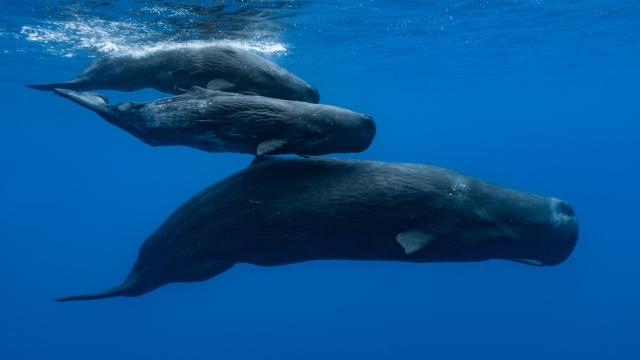Sperm whales’ clicking communiques include context and combination structures that make their messaging more akin to language than previously known, according to a team of researchers at MIT.
Sperm whales (P. macrocephalus) have the largest brains in the animal kingdom. Their clicks are how the whales converse with one another. The nonprofit organization Project CETI (a play on SETI, the Search for Extra-Terrestrial Intelligence, but also short for Cetacean Translation Initiative) seeks to decipher whale codas—snippets of their clicks—to understand not only how whales communicate with one another, but perhaps even what they’re communicating. The team uses robotics to record the whales as they swim and software tools and machine learning to catalogue and associate the sperm whale codas. The team’s research was published today in Nature Communications.
The team used the Dominica Sperm Whale Project’s (DSWP) dataset of over 8,000 whale codas, making it the largest library of sperm whale data. The researchers scrutinized recordings of 60 different sperm whales in the Eastern Caribbean, revealing unique patterns in the whales’ communication that reflected the remarkable complexity of their conversation—whatever they’re talking about.
“Our results show that these whales have a more complex combinatorial communication system that demonstrates rubato and ornamentation, in which whales make sub-second adjustments to match one another as they converse and add extra clicks to known coda types depending on the context within their conversations,” said Shane Gero, a biologist at Carleton University, Project CETI’s biology lead and founder of DSWP, in a project release. “Despite their dramatically divergent evolutionary lineage, sperm whales have aspects within their communication system typically reserved for humans.”

Many animals are intelligent—often more intelligent than we know at first—but we’ve never been able to understand them or their interactions with each other, explicitly through language. In their work, the team document previously unknown aspects of the codas that are “sensitive to the conversational context in which they occur.” The features, called rubato and ornamentation, are imitated across the whales studied in the dataset.
The research team also named two features independent from the conversational context which they named rhythm and tempo. Rubato and ornamentation combine with rhythm and tempo to create the range of whale codas, they concluded, adding that the vocalizations are on the whole “more expressive and structured than previously believed.” Taken together, the factors enabled the researchers to create the whales’ phonetic alphabet. Even though they cannot understand the subject matter being conveyed in the whales’ clicks, the team can explain why one coda may be different from another based on context clues.
“Using machine learning is important for identifying the features of their communications and predicting what they say next,” said Daniela Rus, a computer scientist and roboticist at MIT and director of the institute’s Computer Science & Artificial Intelligence Laboratory, in a CSAIL release “Our next steps aim to decipher the meaning behind these communications and explore the societal-level correlations between what is being said and group actions.”
While Project CETI is dedicated to sperm whales, the repertoire of technologies and techniques developed in the quest to decipher whale communication has far-reaching implications. In a roadmap for understanding whales, published in iScience in 2022, a team including members of Project CETI outlined how massive datasets of whale clicks could be collected and how researchers could use machine learning to identify basic building blocks of communication in them. The sperm whale makes a great first candidate for study, but once science has cracked the code on whale conversation their tools can be applied to other species with complex communication.
No, scientists have not yet talked to whales. We don’t even know what they’re saying, at least not yet. But researchers are starting to grasp patterns in their communication that were previously undetected, an important step in the right direction.
More: Will We Ever Be Able to ‘Talk’ With Our Pets?
